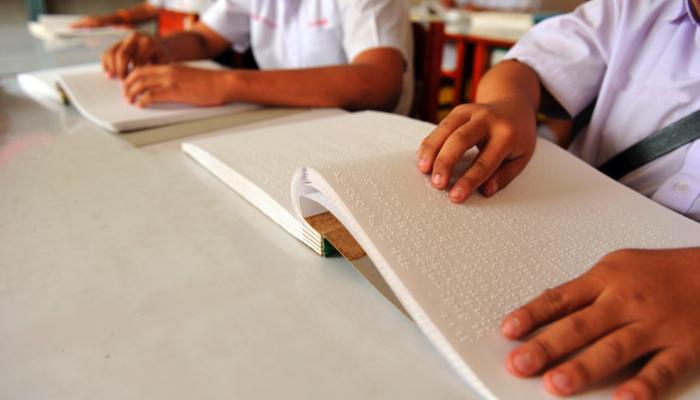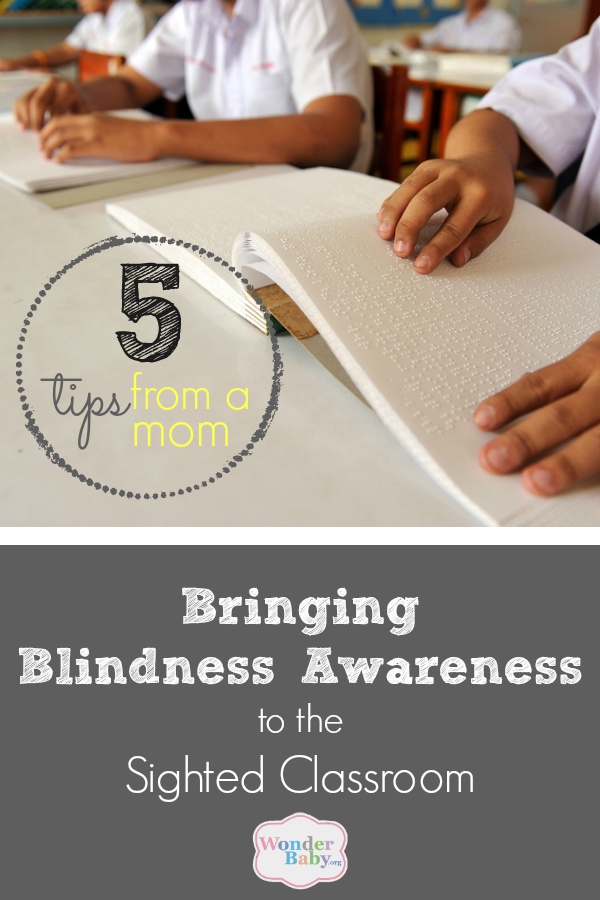Bringing Blindness Awareness to the Sighted Classroom

This post may contain affiliate links; please see our terms of use for details.
By Carol Castellano
This article was adapted by the author, Carol Castellano, from her book Making it Work: Educating the Blind/Visually Impaired Student in the Regular School, copyright 2005, Information Age Publishing, Inc. The article first appeard in Future Reflections Winter/Spring 2006.
A “blindness awareness” presentation is a good way to foster understanding, acceptance, and respect for the blind student in the classroom. A blindness awareness presentation can help sighted students become familiar with the tools and techniques of blindness and learn ways to interact with and include the blind student in activities.
The session can help students realize that their blind classmate is a student just like them who will be learning the same subjects and doing the same assignments but who might be using different tools to get the work done. A blindness awareness presentation can be made by the teacher of the visually impaired, a skilled blind adult, the student himself along with a parent, or a volunteer from an organization such as the National Organization of Parents of Blind Children.
Beware of Simulation
Teachers are often tempted to use simulation exercises to raise awareness and “to show students what it is like to be blind.” In these exercises, sighted students don a blindfold and then attempt to perform various tasks or walk around the school building being guided by a classmate to “build trust.”
What are the goals of such exercises? Sighted students will probably have trouble performing tasks under blindfold that they are accustomed to doing with their eyesight. Is the goal to show them how hard it is to be blind? Sighted students will probably be nervous giving over their safety to a guide who is walking them around. Is the goal to show that blind people are helpless and dependent and must put their trust in good-hearted sighted people in order to get anywhere or to keep from falling down a flight of stairs?
Before you embark on such an activity, think about what you want the students to learn. Wearing a blindfold for a little while might show what it would be like to suddenly lose vision, but it certainly does not show what it is like to be blind. Real blind people learn a series of skills that enable them to perform tasks without or with very little eyesight. Likewise, real blind people learn mobility skills so that they can trust themselves and get where they need to go.
If children are blindfolded but are not taught any of the skills that real blind people use, they are likely to emerge from a simulation experience feeling that blindness is scary, sad, and difficult. Is this what you want them to think blindness is like?
Instead of fostering acceptance, understanding, and respect, these exercises engender sadness, fear, and pity. Instead of thinking of their blind classmate as a potential friend, students can end up feeling more distant from their blind classmate and feeling sorry for him or her.
A better way to foster understanding and promote friendships is through a presentation that will promote respect for the blind student and the skills and tools she will be using.
Discussion Topics
Read the stories of Erik Weihenmayer, the blind man who successfully climbed Mt. Everest, Abraham Nemeth, the blind mathematician who created the Braille code for mathematics, and Geerat Vermeij, a blind biologist. Your students might enjoy learning how to read and write a few simple words in Braille. You can purchase the program Braille Is Beautiful for your class or school. This curriculum program provides an educational video, a history of Braille, biographies of famous blind people, Braille games and activities, tools for writing Braille, a Braille service project, and other materials for learning about blindness and Braille. These stories and materials will provide background and factual information for the following possible discussion topics:
- How do blind people accomplish tasks?
- What jobs do blind people do?
- How might blind people use their other senses?
- What skills and tools do blind people learn in order to do their schoolwork, get to the supermarket, cook a meal, do their jobs?
- How does Braille work?
- How can we get our blind classmate into games?
Special Items
Ask your presenter to show students items such as print-Braille and large print books, Braille and large print rulers and tape measures, a Braillewriter or slate and stylus, a talking and large print calculator, a talking dictionary, a coloring screen, Braille and large print playing cards, a bell ball, etc.
Cane Travel Discussion and Demonstration
A cane travel discussion and demonstration is effective in helping students understand that their blind classmate will be learning travel techniques that will enable him to move about safely and independently. Discussion topics can include the following:
- How do blind people move about independently?
- How can a person get information without eyesight?
- How does the cane work?
In addition to demonstrating basic cane use, your presenter can show students how a blind person gets information through the cane, identifies different surfaces, gets around obstacles, and goes up and down stairs.
Trying It Out
Give students some hands-on experiences with the tools and techniques of blindness. Here are some examples:
- Have the blind student or adult presenter write each child’s name in Braille on a piece of paper that the children can take home.
- Point out that the number five on a phone pad usually has a tactile marking that blind people use as a reference point when dialing; let students try to find the marking using their sense of touch. Some might then want to locate the other numbers.
- Children often wonder how a blind person can eat without being able to see. Put several plastic forks and spoons in a bag; have the students reach in the bag and retrieve either the spoons or the forks. They will see how easily they were able to discern which was which. Then have them close their eyes and see if they can get a spoon to their mouths. Point out that they probably brush their teeth without looking.
- Brainstorm with the class about how people could accomplish various tasks without eyesight.
- Set up role play situations in which one child closes her eyes and a partner tries to show her an object. Students will soon see that using words and putting the object into the blind child’s hands will be effective.
- Brainstorm ways to get the blind child into games. For example, in a game of kickball, instead of rolling the ball to the blind student, the ball could be placed in front of him or her.
Activities like these teach skills and broaden awareness. The blind child will probably enjoy the attention given to his methods; the sighted children will enjoy the success they experienced and the understanding they gained and will feel empowered to interact with their blind classmate. These experiences will foster the idea that their blind classmate can be a friend and an equal, and friendship and equality beat charity and pity any day.
This article was adapted by the author, Carol Castellano, from her book Making it Work: Educating the Blind/Visually Impaired Student in the Regular School, copyright 2005, Information Age Publishing, Inc. The article first appeard in Future Reflections Winter/Spring 2006.

Related Posts

Eye Conditions and Syndromes, Visual Impairment
Neuralink Announces Plans to Restore Sight to the Blind with Brain Chip
Elon Musk’s company Neuralink has announced plans to begin human trials of its new “Blindsight” brain chip by the end of 2025.

Visual Impairment
The Gift of Understanding: How a Young Child Helps His Blind Father Navigate Life
When a parent is blind, it’s natural for people to wonder how their sighted child will adapt. Will they struggle to understand their parent’s needs? Will they feel burdened by...

Braille and Literacy, Toys, Visual Impairment
24 Braille Toys for Kids Who are Blind
Everything from alphabet blocks to raised line coloring pages and activity books to puzzles to card and board games... and so much more! And it's all in braille ready for...